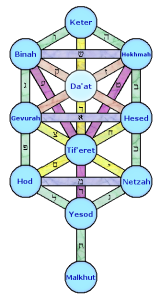
In Genesis, the Tree of Life is the source of everlasting life, and God sends Man from the Garden so that he will not have this after also having the knowledge of good and evil. But what is this tree, really?
In the Kabbalah (the Jewish science of nature), the Tree of Life is a symbol—a network of connected nodes. Each node has meaning, like wisdom or compassion. There are various paths between the nodes and these have meaning, too. How is this Tree of Life related to the Tree of Life which exists in the Garden? Is it the same?
Genesis 3 ends with the words, “Tree of Life.” It is perhaps by design that the following two Genesis chapters (4 and 5) contain the Kabbalah’s Tree of Life. The Genesis Code discussed on this website, and in the book, The Bible’s Hidden Wisdom, reveals this symbol embedded in these two chapters. Why would such an important concept be hidden in Genesis? What is the purpose of this Tree of Life? What is its relation to the “everlasting life” discussed by Jesus?
Why is the “Tree of Life” Hidden in Genesis?

Genesis 3 introduces the “Tree of Life”—a source of immortality or “everlasting life.” Jesus talks of this “everlasting life” saying that we need to give up our lives in order to gain it. This immortality is the subject of another topic on this website. Here, I’m interested in exploring the significance of the “Tree of Life.”
Jesus didn’t talk about this “Tree of Life” during his ministry. He didn’t say we need to seek it out to gain the everlasting life promised us. And certainly it seems clear that that this “tree” is not a physical plant, just as the forbidden fruit was not physical plant material and just as Adam and Eve did not suffer a physical death.
The Kabbalah includes a “Tree of Life” in its teachings. This consists of ten nodes in a matrix pattern. Sometimes, this includes an 11th node called, “Da’at,” but this is only when another node is withdrawn, so the number always remains ten.
In Genesis, “Tree of Life” is Etz Chaim. The Tree of Life article in Wikipedia tells us that this is “a common term used in Judaism. The expression, found in the Book of Proverbs, is figuratively applied to the Torah itself. Etz Chaim is also a common name for yeshivas and synagogues as well as for works of Rabbinic literature. Further, it is also used to describe each of the wooden poles to which the parchment of a Sefer Torah is attached.”
The Wikipedia article also says of “Etz Chaim” (“Tree of Life”) that it is “figuratively applied to the Torah itself: ‘It [the Torah] is a Tree of Life to those who cleave to it.’“
Thus, this everlasting life seems to be the purpose of it all. Every biblical word, every story, every idea in the Bible has but one purpose—our own reclaiming of everlasting life.
The “Tree of Life” is also mentioned in Revelations in three places: Revelation 22:2, 19, and,
“Whoever has ears, let them hear what the Spirit says to the churches. To the one who is victorious, I will give the right to eat from the tree of life, which is in the paradise of God” (Revelation 2:7).
“Etz Chaim” are the last two words of Genesis 3—the chapter where Adam and Eve were escorted out of the Garden. The fact that the Kabbalah’s “Tree of Life” pattern is to be found embedded in Genesis 4 and 5 seems to make a pointer out of those last two words of Genesis 3.
Here is the “Tree of Life” found in Genesis 4 and 5:

Why Hidden?
We find clues throughout the Bible. Each one of these clues makes clear the importance of humility. We find it in the humble sacrifice of Abel, but not in that of his brother, Cain. We find it in the obedience of Abraham when he takes Isaac into the wilderness to be sacrificed. We find it in the lessons of Jesus when he tells us what he doesn’t like about the behavior of the Pharisees.
But we also find clues in human nature. When someone is certain they know the answers, they stop looking. That certainty can be “arrogance” or it can be “faith.” What’s the difference? Humility is the difference between arrogance and faith. When a scientist assumes that they know it all (and some do), they are being arrogant. They won’t find new answers. Finding new answers requires humility—an openness to receive something new.
If humility is the key to the “Tree of Life,” and humility is required to find answers hidden in the Bible, then one can be certain that a great deal of wisdom has been hidden in this Holy Book in order to elicit a never-ending flood of humility.
Rod Martin, Jr.
The Bible’s Hidden Wisdom
This article was originally published 2011:1223 on GenesisCode.net/blog.
